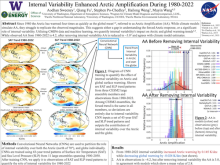Internal Variability Increased Arctic Amplification during 1980-2022
Aodhan
Sweeney
University of Washington Department of Atmospheric Sciences
Poster
Since 1980, the Arctic surface has warmed four times faster than the global mean. Enhanced Arctic warming relative to the global average warming is referred to as Arctic Amplification (AA). While AA is a robust feature in climate change simulations, models rarely reproduce the observed magnitude of AA, leading to concerns that models may not accurately capture the response of the Arctic to greenhouse gas emissions. Here, we use CMIP6 data to train a machine learning algorithm to quantify the influence of internal variability in surface air temperature trends over both the Arctic and global domains. Application of this machine learning algorithm to observations reveals that internal variability increases the pace of warming in the Arctic but slows global warming in recent decades, inflating AA since 1980 by 38% relative to the externally forced AA. Accounting for the role of internal variability reconciles the discrepancy between simulated and observed AA.

sweeney-aodhan-polar-poster.pdf
(3.12 MB)
